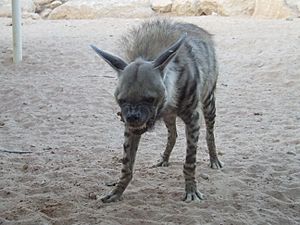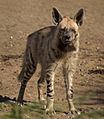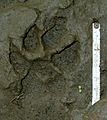Striped hyena facts for kids
The striped hyena (Hyaena hyaena) is a wild animal found across a wide area. It lives in North Africa, East Africa, the Middle East, the Caucasus mountains, Central Asia, and the Indian subcontinent. Scientists list it as "near threatened" because its numbers are decreasing. There might be fewer than 10,000 adult striped hyenas left in the world. People sometimes hunt them, and their food sources are shrinking.
Quick facts for kids Striped hyaenaTemporal range:
Middle Pleistocene – Recent |
|
|---|---|
 |
|
| Striped hyaena at a zoo in Nepal | |
| Conservation status | |
| Scientific classification | |
| Kingdom: | |
| Phylum: | |
| Class: | |
| Order: | |
| Family: | |
| Genus: | |
| Binomial name | |
| Hyaena hyaena (Linnaeus, 1758)
|
|
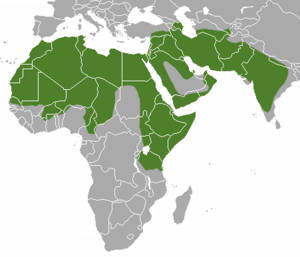 |
|
| Striped hyena range | |
The striped hyena is the smallest type of hyena in its group. It has some features that are older, like a smaller and simpler skull, which are not seen in larger hyena species.
These hyenas mostly eat dead animals, acting as nature's clean-up crew. However, bigger ones can sometimes hunt their own prey. Attacks on humans are very rare. Striped hyenas usually live in pairs, with both the male and female helping to raise their young. They are active at night, coming out only when it's completely dark. They quickly return to their dens before the sun rises. If attacked, they might pretend to be dead. They are also known to stand up to bigger predators, like leopards, if they are fighting over food.
The striped hyena is often mentioned in old stories from the Middle East and Asia. It even appears in the Hebrew Bible.
Contents
About the Striped Hyena's Body
What Does a Striped Hyena Look Like?
The striped hyena is the second largest hyena. It's bigger than the brown hyena but smaller than the spotted hyena. Its head is not as big as a brown hyena's. Its teeth are also not as strong, meaning it eats a wider variety of foods.
It's a medium-sized animal with a back that slopes downwards. Its head is roundish with a pointed snout and pointed ears. Their fur is usually pale grey or beige. They have a black patch on their throat. They also have 5 to 9 clear black stripes going down their sides. Their legs have black stripes too. In summer, their stripes are much darker and clearer than in winter.
A special feature is the mane of hair along its back. When the hyena feels threatened, it can make this mane stand up. This makes the hyena look 38% bigger, which helps scare away enemies. The mane also helps them communicate with other hyenas. They have a long, bushy tail that is black and white. Their feet have four toes with short, blunt claws that cannot be pulled back.
Male striped hyenas usually weigh between 26 and 41 kilograms (57–90 pounds). Females weigh a bit less, from 26 to 34 kg (57–75 lb). Their body length, not including the tail, is about 1.0 to 1.15 meters. They stand about 0.66 to 0.75 meters tall at the shoulder. Striped hyenas also have special scent glands near their bottom, which are like small, hairless pouches.
How Striped Hyenas Reproduce
Striped hyenas usually have 1 to 4 cubs at a time in the wild, with 3 being the average. In zoos, they can have 1 to 5 cubs. Before giving birth, the female digs a lot. Cubs are born blind and with their ears closed. Their fur is white to grey with clear black stripes.
Cubs open their eyes after about 7 to 8 days. Their teeth start to grow after 3 weeks. They begin eating solid food after one month. They stop drinking milk from their mother between 8 weeks and 12 months old. Both the male and female hyenas help feed the cubs. The age when they can have their own cubs varies. One female in a zoo had her first litter at four years old. However, some wild hyenas in Israel were found to be pregnant at just 15 months old.
Striped Hyena Behaviour
How Striped Hyenas Live Together

Striped hyenas are more private than spotted or brown hyenas. They tend to live alone or in very small groups. Usually, a group has only 1 or 2 hyenas, though groups of seven have been seen in Libya. In Israel, hyenas are mostly solitary. However, they might gather together if there's a large dead animal to eat. Hyenas in Central Asia often live in pairs, with one male and one female.
Unlike spotted hyenas, striped hyenas don't seem to defend their territory very strongly. In the Serengeti, two hyenas had home areas of about 44 and 72 square kilometers. A female hyena in the Negev desert had a home area of about 61 square kilometers.
When two striped hyenas meet, they sniff each other's noses. They also sniff special scent pouches near their bottoms. They might gently paw at each other's throats. If they are fighting, the black patch on their back stands up. When they bite, they aim for the throat and legs, but they avoid the mane. Striped hyenas mark their territory by rubbing their scent glands on grass, stones, and tree trunks. They make fewer sounds than spotted hyenas.
What Striped Hyenas Eat
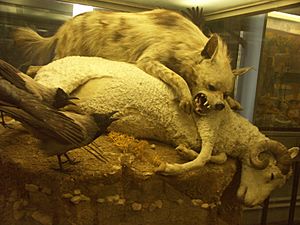
Striped hyenas mostly eat dead animals. They are excellent scavengers. They use their strong jaws to chew and crush bones from the remains of other predators' meals. Sometimes, they do hunt live prey. It's thought that only the larger striped hyenas in Northwest Africa, the Middle East, and India hunt big animals. Smaller hyenas in East Africa and the Arabian Peninsula don't seem to attack large plant-eating animals.
In Turkmenistan, striped hyenas have been seen eating many tortoises. They also hunt wild boar, kulan (a type of wild donkey), and porcupine. In the Caucasus mountains, grasshoppers are their main food.
Striped hyenas also eat plants to add to their meat diet. In Uzbekistan and Tajikistan, they eat a lot of oil willow fruits when they are in season. In Israel, hyenas eat fruits, especially dates and melons. Striped hyenas can drink different kinds of water, including fresh water, soda water, and even salt water. Eating melons can also help them get enough liquids. They have also been seen eating at landfills, which are places where trash is dumped.
How Striped Hyenas Interact with Other Animals
Striped hyenas often eat the leftovers from other predators' hunts. This can lead to arguments. In Africa, striped hyenas are usually less dominant than bigger predators like lions and spotted hyenas when fighting over food. However, one hyena expert noted that spotted and striped hyenas seem to have some kind of connection. When it comes to single predators like leopards and cheetahs, it's harder to tell who will win. The outcome often depends on who scares the other first.
In India and the Middle East, striped hyenas sometimes clash with wolves. Even though a single hyena is stronger, wolves usually hunt in groups, which gives them an advantage. Striped hyenas in India might dominate very young tigers. But they generally wait until an adult tiger has left before scavenging from its kills. Parts of hyenas have also been found in the stomachs of mugger crocodiles.
Striped Hyena Subspecies
Scientists have identified five main types, or subspecies, of striped hyenas. They are different in their fur and body measurements.
- Hyaena hyaena syriaca: Found in the Middle East.
- Hyaena hyaena sultana: Found in the Arabian Peninsula.
- Hyaena hyaena dubbah: Found in Northeast Africa.
- Hyaena hyaena barbara: Found in Northwest Africa.
- Hyaena hyaena hyaena: Found in India.
The subspecies H. h. sultana and H. h. dubbah are smaller than the three northern subspecies. Striped hyenas in Lebanon are said to have reddish fur. Those in the Arabian Peninsula have yellow marks below their eyes. Their manes are a mix of grey and black, not completely black.
Not all scientists agree on these subspecies. Some believe they are all just variations of the same Hyaena hyaena species.
Striped Hyenas and Humans
Impact on Farms and Crops
How much striped hyenas affect farm animals depends on the area. In Lebanon, there are very few reports of attacks. Some stories even say hyenas walk through fields without bothering the animals. However, in Turkmenistan, striped hyenas are sometimes more serious predators of farm animals than wolves.
Surveys show that goats, sheep, dogs, and poultry (like chickens) are the most common farm animals killed by striped hyenas. There are stories of hyenas eating larger animals, but it's not always clear if the hyenas actually killed them or just ate them after they were already dead. Attacks on larger farm animals are rare. More farm animal attacks are reported in Egypt, Ethiopia, India, Iraq, and possibly Morocco. Dogs are the most common targets in Turkmenistan and India. In the Caucasus region, dogs, sheep, and other small farm animals are sometimes killed. Reports from the 1950s in Iraq mention attacks on horses and donkeys. In Africa, dogs, sheep, and goats are occasionally at risk.
Striped hyenas sometimes raid Melon fields and date palm farms in Israel and Egypt. In Turkmenistan, they often target watermelon and honeydew fields.
Images for kids
-
A pair of striped hyenas fighting at the Colchester Zoo
-
Stuffed striped hyena defending a sheep carcass from hooded crows, as shown in The Museum of Zoology, St. Petersburg
-
A striped hyena being speared in British India, as illustrated in the Illustrated London News
-
An Ancient Egyptian mural showing a striped hyena being forcefed
See also
 In Spanish: Hiena rayada para niños
In Spanish: Hiena rayada para niños




